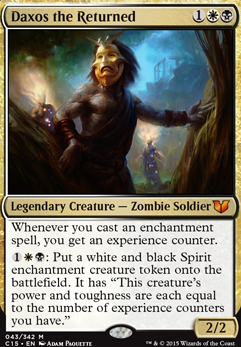Enchantment (26)
- 1x Anointed Procession
- 1x Attrition
- 1x Authority of the Consuls
- 1x Blind Obedience
- 1x Cathars' Crusade
- 1x Dictate of Erebos
- 1x Exquisite Blood
- 1x Flickering Ward
- 1x Ghostly Prison
- 1x Grasp of Fate
- 1x Greater Auramancy
- 1x Hallowed Haunting
- 1x Karmic Justice
- 1x Land Tax
- 1x Leyline of the Void
- 1x Luminarch Ascension
- 1x No Mercy
- 1x Phyrexian Arena
- 1x Sigil of the Empty Throne
- 1x Smothering Tithe
- 1x Sphere of Safety
- 1x Starfield of Nyx
- 1x Trouble in Pairs
- 1x Underworld Dreams
- 1x Wound Reflection
Artifact (9)
Land (36)
- 1x Ancient Tomb
- 1x Arid Mesa
-
1x
Bloodstained Mire

- 1x Caves of Koilos
- 1x Command Tower
- 1x Exotic Orchard
-
1x
Fetid Heath

-
1x
Flooded Strand

- 1x Godless Shrine
- 1x Isolated Chapel
-
1x
Mana Confluence

- 1x Marsh Flats
- 1x Nykthos, Shrine to Nyx
- 8x Plains
- 1x Polluted Delta
- 1x Reflecting Pool
- 1x Reliquary Tower
- 1x Serra's Sanctum
- 1x Shambling Vent
- 5x Swamp
- 1x Tainted Field
- 1x Temple of Silence
- 1x Vault of the Archangel
- 1x Verdant Catacombs
-
1x
Windswept Heath

Instant (7)
Commander (1)
Creature (16)
- 1x Aegis of the Gods
- 1x Ajani's Chosen
- 1x Archon of Sun's Grace
- 1x Athreos, God of Passage
- 1x Celestial Ancient
- 1x Doomwake Giant
- 1x Erebos, God of the Dead
- 1x Esper Sentinel
- 1x Fate Unraveler
- 1x Grand Abolisher
- 1x Grim Guardian
- 1x Heliod, Sun-Crowned
- 1x Mesa Enchantress
- 1x Mondrak, Glory Dominus
- 1x Underworld Coinsmith
- 1x Weathered Wayfarer
Sorcery (5)
Suggestions
Updates Add
Comments
Attention! Complete Comment Tutorial! This annoying message will go away once you do!
Important! Formatting tips — Comment Tutorial — markdown syntax
Please login to comment
99% Casual
Competitive
| Date added | 7 years |
| Last updated | 1 week |
| Legality | This deck is Commander / EDH legal. |
| Rarity (main - side) | 15 - 0 Mythic Rares 54 - 0 Rares 13 - 0 Uncommons 5 - 0 Commons |
| Cards | 100 |
| Avg. CMC | 2.92 |
| Tokens | Angel 4/4 W, Cat 2/2 W, Enchantment Spirit */* WB, Experience Token, Pegasus 2/2 W, Spirit Cleric */* W, Treasure |
| Folders | Dax decks, Reference Decks, Deck Inspiration |
| Votes | |
| Ignored suggestions | |
| Shared with | |
| Views |

